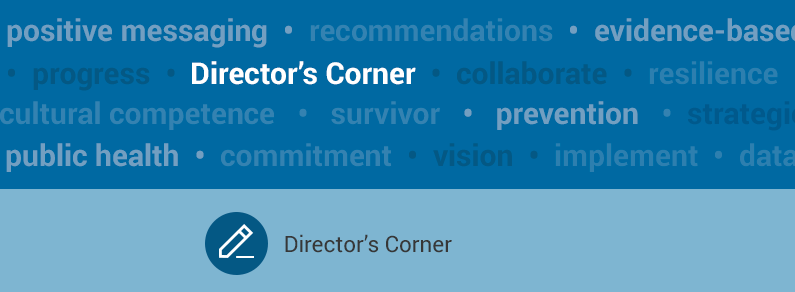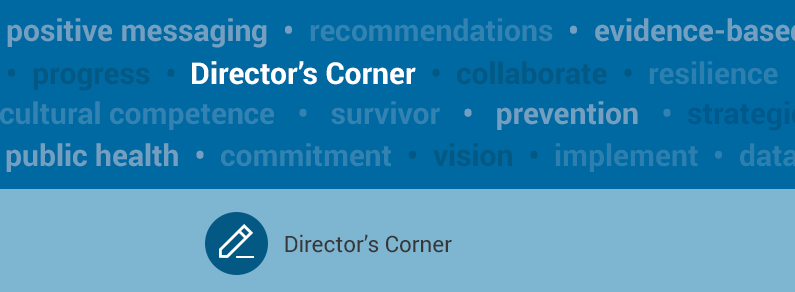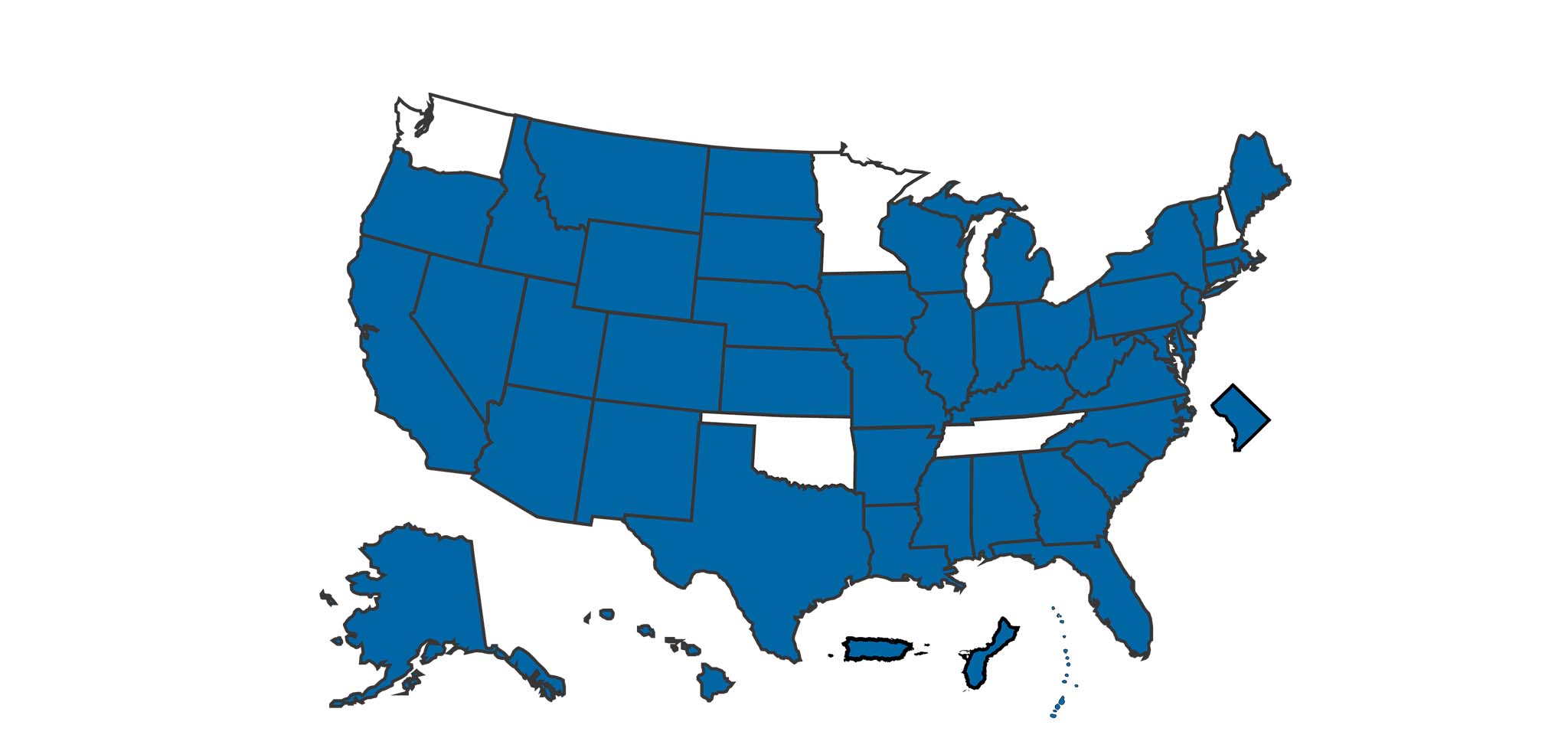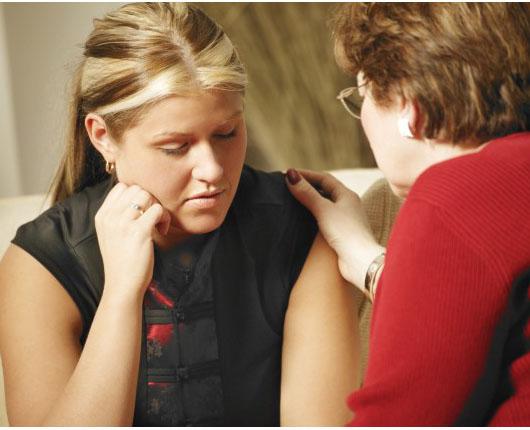Search Results for: role of the media
-
Suicide Narratives in the News Media: What Effect Might They Have and What Can We Do?
The news media do more than report facts, they tell stories about events and people. These narratives can influence public perceptions about issues, including their causes and appropriate solutions. For example, extensive news coverage of suicides among LGBT youth, military service members, and individuals affected by the U.S. economic crisis has created a basic storyline […] See more...
-
Exploring the Impact of Suicide Prevention Research in Social Media
On Friday, August 14, 2015, ICRC-S hosted “Exploring the Impact of Suicide Prevention Research in Social Media,” with speakers Thomas Niederkrotenthaler, M.D., Ph.D., M.M.Sc. and Benedikt Till, D.Sc. Recent developments in the field of media and suicide research reflect a change in focus from traditional to online media and an increasing attention to stories of […] See more...
-
INTERNATIONAL: PAHO Reports Changes to Media Coverage of Suicide
St. Lucia Times In Latin America, journalists are increasingly playing a key role in suicide prevention. The Pan American Health Organization (PAHO) has rolled out training to the region on how to safely and accurately report on suicide. More than 130 participants from 30 countries completed training in 2017. After attending a workshop on addressing […] See more...
-
News and Entertainment Play Important Role in Shaping National Suicide Narrative
The National Action Alliance for Suicide Prevention (Action Alliance) has released a statement to reporters on the important role of the media in helping to prevent suicide. It was developed by the Action Alliance Changing the Conversation Priority Workgroup, which leverages the news media, entertainment industry, and suicide prevention messengers to change the national script around suicide […] See more...
-
Exploring the Impact of Suicide Prevention Research in Social Media
Recent developments in the field of media and suicide research reflect a change in focus from traditional to online media and an increasing attention to stories of hope and recovery and their potential to help prevent suicide. This webinar will focus on recent research investigating how stories of recovery impact various audiences, and on the role of […] See more...
-
Toward Zero Suicide: The Essential Role of Data

Zero Suicide is a systematic approach to preventing suicide in health care and behavioral health settings. The Zero Suicide approach is based on a commitment to patient safety and a belief, informed by data, that health and behavioral health care systems can prevent suicides among the people in their care. Because of the risks faced […] See more...
-
The Role of Primary Prevention

When we talk about suicide prevention, we usually refer to “prevention” writ large, meaning anything and everything we do to prevent suicide. But the word “prevention” can actually be used to refer to three types of activities: 1) Primary prevention, which seeks to prevent the onset of a condition 2) Secondary prevention, which seeks to […] See more...
-
Be the Change: How to Support Suicide Prevention Efforts This September

This Suicide Prevention Month, let's encourage everyone to get involved. See more...
-
Inclusion Is Key to Mental Health

Celebrate mental health awareness and Asian American, Native Hawaiian, and Pacific Islander communities by weaving inclusivity into everything you do. See more...
-
Teen Girls Report Record Levels of Sadness, CDC Finds
The New York Times Recent national data suggest teen girls are experiencing increased sadness, suicidal thoughts, and sexual violence. The data come from the Centers for Disease Control and Prevention’s (CDC) Youth Risk Behavior Survey, which is carried out every two years in high schools across the country. The latest survey also found high rates […] See more...
-
State and Territorial Suicide Prevention Needs Assessment Homepage

SPRC’s annual State and Territorial Suicide Prevention Needs Assessment (SNA) examines the suicide prevention infrastructure and capacity of U.S. states and territories. See more...
-
Zero Suicide
Zero Suicide is a commitment to suicide prevention in health and behavioral health care systems and is also a specific set of strategies and tools. The foundational belief of Zero Suicide is that suicide deaths for individuals under care within health and behavioral health systems are preventable. Zero Suicide presents both a bold goal and […] See more...
-
Resources to Support Mental Health and Coping with the Coronavirus (COVID-19)
The Suicide Prevention Resource Center (SPRC) has compiled a selection of web pages and information sheets on mental health and coping with the effects of COVID-19. These resources are a selection from key organizations in the field. We will continue to update this list as new resources become available. *Note: For crisis counseling and support […] See more...
-
Exploring the Impact of Suicide Prevention Research in Faith-Based Communities
On Tuesday, May 19, 2015, 2:00 p.m. – 3:00 p.m. Eastern Time the ICRC-S hosted the webinar”Exploring the Impact of Suicide Prevention Research in Faith-Based Communities” with speakers Dr. Sherry Molock of George Washington University and Rev. Phyllis Jackson of the Rochester, New York area. Faith communities can work to prevent suicide by enhancing many of the […] See more...
-
Zero Suicide Webinar: After a Suicide: Postvention in Health and Behavioral Healthcare Settings
A patient’s death by suicide in health and behavioral healthcare organizations can have a significant impact on family members, other patients, and staff. It may be even more destabilizing or demoralizing in systems where significant changes to improve suicide care had been implemented. Optimal postvention practices in health and behavioral healthcare organizations highlight immediately supporting […] See more...
-
White Mountain Apache/Johns Hopkins University
The White Mountain Apache Tribe (WMAT) has experienced high rates of youth suicide deaths and attempts for over two decades. Although Apache youth are exposed to a challenging constellation of risk factors, the WMAT has a long history of overcoming health disparities by implementing and evaluating evidence-based interventions in partnership with Johns Hopkins. Over the […] See more...
-
White Mountain Apache/Johns Hopkins University
The White Mountain Apache Tribe, in partnership with John Hopkins, plans to amplify its existing youth suicide prevention program with the current grant. The proposed initiative, titled “Empowering our Spirits,” will deploy a three-tiered prevention strategy (universal, selective, indicated) including three culturally-adapted evidence-based interventions that build on unique tribally mandated suicide surveillance system. Primary intervention […] See more...
-
University of Tennessee – Knoxville
The VolAware Suicide Prevention Initiative will target students with a mental health condition, students under 21, males, LGBT students, African Americans, Asians, and Hispanics. The activities will target the campus; however, media, the internet, and e-mail will allow social marketing messages and educational literature to reach parents/families, commuter students, and students studying abroad. Critical first […] See more...
-
University of San Diegoc
The University of San Diego Suicide Prevention Grant will provide a comprehensive array of initiatives to mitigate the risk of suicide and to promote help-seeking behavior. Through enhanced collaborations, trainings and other educational interventions the University of San Diego plans: to 1) increase the awareness of mental health concerns, suicide risk and protective factors, 2) […] See more...
-
Turtle Mountain Band of Chippewa Indians
The Turtle Mountain Band of Chippewa Indians live on a 6 by 12 mile reservation in Rolette County, extreme north-central North Dakota. Tribal members have long suffered from severe poverty and accompanying social stresses which threaten the social fabric of our community. Median household income is less than two-thirds of national levels; 65% of adults […] See more...
-
Omaha Tribe of Nebraska
Project HOPE, a community-based initiative will focus upon the prevention of suicides among the Omaha youth, focusing on a initial target of 200, 10-24 year olds. Suicide is a serious public health concern that results in approximately 4,400 lost lives each year as the second leading cause of death among American Indian adolescents and young […] See more...
-
New Hampshire – NAMI New Hampshire
Connect Garrett Lee Smith (CGLS) strives to reduce suicide incidents by supporting the NH Suicide Prevention Council (SPC) to implement the State Plan and increase capacity on the individual, community and systems level for suicide prevention and postvention. CGLS improves access to mental health care through early intervention and referral, builds caring communities, clarifies service […] See more...
-
Law Enforcement
-
Justice System
-
Health Care
Health care includes a variety of settings, including primary care practices, hospitals, emergency departments, behavioral health care, and substance abuse treatment facilities. All of these settings can play an important role in suicide prevention by identifying suicide risk and providing effective care. As physical health problems can also increase suicide risk, providing care for illnesses, substance use disorders, and chronic health problems may also […] See more...
-
First Responders
First responders, including emergency medical services (EMS) personnel and firefighters, can assist individuals in a suicidal crisis, as well as those who may be affected by a suicide death or attempt. First response agencies also have a role to play in assisting their own staff, who may experience increased risk of suicide as a result […] See more...
-
Crisis Centers/Services
-
Substance Abuse Treatment
Settings that provide treatment for substance use disorders have an important role to play in suicide prevention. Guidelines for addressing suicidal thoughts and behaviors in substance abuse treatment are available from the Substance Abuse and Mental Health Services Administration (SAMHSA). Actions to consider include: Routinely screening for suicide risk Preparing a treatment plan to address suicidality Ensuring continuity of […] See more...
-
Youth
Suicide is an important problem affecting young people (see our Scope of the Problem section for suicide-related data). Youth encompass many different subgroups in terms of age and developmental stage, sex, cultural background, and other characteristics. Suicide prevention efforts should seek to identify and address the risk and protective factors that are most relevant to each targeted group (e.g., adolescent Latinas). Family members, […] See more...
-
Asian Americans and Pacific Islanders
Asian Americans include people originating from China, India, the Philippines, Vietnam, and other countries in Asia. Pacific Islanders are a much smaller group consisting primarily of individuals originating from Hawaii, Guam, and Samoa. Suicide rates, risk and protective factors, and the suicide prevention strategies that are most appropriate may vary across groups. Suicide prevention programs […] See more...
-
Core Competency: Communication and Marketing
Communication comes into play at every step of your grant effort. To involve stakeholders and get community buy-in, you need to communicate your program goals and how they relate to local priorities. Many grantees develop social marketing or awareness campaigns during their grant to promote help seeking among youth or to obtain support from friends […] See more...
-
George Mason University
George Mason University currently has more than 32,000 students and is located within the Washington, D.C. metropolitan area, and as such Mason’s Counseling and Psychological Services (CAPS) serves a highly diverse group of students. However, some groups are less likely to seek out mental health services and be seen at CAPS. Unfortunately, these same groups […] See more...
-
Faith Communities
-
Behavioral Health Care
-
Schools
-
Risk and Protective Factors
Suicide prevention seeks to reduce the factors that increase suicide risk while increasing the factors that protect people from suicide. Risk Factors Risk factors are characteristics of a person or his or her environment that increase the likelihood that he or she will die by suicide (i.e., suicide risk). Major risk factors for suicide include: […] See more...
-
SMA Behavioral Health Services, INC
Abstract: SMA Behavioral Health Services, Inc., a four county behavioral health system, will utilize Zero Suicide funding to implement Adult Zero Suicide, a suicide prevention and intervention program for individuals 25 years of age and older, that raises staff awareness of suicide, establishes referral processes, and improves care and outcomes for individuals who are at […] See more...
-
Native American Development Corporation
Billings Urban Indian Health and Wellness Center (BUIHWC) under the nonprofit status of Native American Development Corporation (NADC) will be submitting a SAMHSA Garrett Lee Smith State/Tribal Youth Suicide Prevention & Early Intervention Grant application. The purpose of this project will be to implement youth suicide prevention and early intervention strategies. The purpose of this […] See more...
-
Build
A key function of state suicide prevention programs is to oversee the implementation and evaluation of suicide prevention programming. To maximize resources available for program implementation, state-level efforts must include a combination of strategies that are supported by the best available evidence, are most appropriate for their context and populations, and are best able to […] See more...
-
Examine
State suicide prevention efforts must be data driven in order to be effective, and in order to determine effectiveness and continuously improve, the efforts must be evaluated. As a result, capabilities related to data collection, analysis, use, evaluation design, and dissemination are needed. No single source can provide all data needed to understand the suicide […] See more...
-
Partner
As described in the National Strategy for Suicide Prevention, suicide prevention requires a multifaceted approach that focuses on risk and protective factors at individual, family, community, and societal levels. As a result, prevention efforts are more likely to succeed when they involve multiple partners from the public and private sectors to increase the capacity and […] See more...
-
Lead
Suicide prevention efforts are more likely to succeed when spearheaded by experienced, capable leaders who combine knowledge of suicide prevention with skills in program administration, coalition building, goal setting, communication, and other foundational areas. Recommendations To further strengthen your infrastructure See more...
-
Step 6: Implement, Evaluate, and Improve
In Step 6, you ensure that your activities are implemented as planned, document progress toward your long-term goals, and share your findings. To see an example of what Step 6 involves, take a look at the case study in SPRC’s online course A Strategic Planning Approach to Suicide Prevention. Ensure Your Activities Are Implemented as […] See more...
-
Step 3: Identify Key Risk and Protective Factors
In Step 1 and Step 2 of the strategic planning process, you used data and other information to describe suicide and its context in your community and to identify a set of long-term goals. In Step 3, you will focus on identifying the risk and protective factors that can help you reduce the suicidal behavior identified in […] See more...
-
Topics and Terms
This page offers definitions of terms commonly used in suicide prevention. Many of these terms are also used in other public health and behavioral health contexts, where they may be defined somewhat differently. Acute phase, suicidal crisis The acute phase is the period in which an individual experiencing a suicidal crisis is at imminent risk […] See more...
-
National Strategy for Suicide Prevention: Following Our Compass

SPRC invites you to join us in taking action to build on the progress we have made in bringing the goals and objectives of the National Strategy to life over the past decade. See more...
-
COVID-19 and Suicide – Why Our Messaging Matters
The HPHR Journal A recent opinion piece calls for more accurate and action-oriented messaging about the mental health impacts of the COVID-19 pandemic. The authors share guidance from the National Action Alliance for Suicide Prevention’s Messaging Work Group, which has developed key messages about mental health and suicide prevention in the context of COVID-19. These messages include […] See more...
-
A New Partnership for Suicide Prevention

This Suicide Prevention Month, we have some good news to celebrate: the Suicide Prevention Resource Center (SPRC) has been funded for another five years! We are delighted to announce a new partnership between the University of Oklahoma Health Sciences Center (OUHSC), the University of Oklahoma Outreach Southwest Prevention Center (SWPC), and Education Development Center (EDC) […] See more...
-
Suicide Prevention in Schools: Strategies for COVID-19

Addressing the mental health needs of students in school communities is more important than ever before. The COVID-19 pandemic has exacerbated the stress and trauma faced by many students while bringing new challenges, such as isolation and increased risk for adversity at home. Schools play a unique and critical role in addressing the pandemic’s potential mental health effects and preventing suicide. While […] See more...
-
COVID-19 Suicide Prevention Messaging
The National Action Alliance for Suicide Prevention (Action Alliance) Media Messaging Workgroup has developed guidance for messaging to the public about suicide prevention during the COVID-19 pandemic. The guidance includes key messages to help ensure suicide prevention communications are accurate, effective, and consistent. Action Alliance and its partners have also released a joint statement to reporters about the role of news […] See more...
-
Best Practices for Reporting on Suicide
Members of the media play a critical role in suicide prevention. SPRC encourages news outlets to follow best practices for safe and accurate reporting on suicide, including supplemental recommendations for reporting on suicide during the COVID-19 pandemic. To help the public cope in this uncertain time, please consider sharing our compilation of resources to support mental health during COVID-19 and messaging guidance from the […] See more...
-
Faith Communities as Suicide Prevention Partners

Brandon Johnson, MHS; Melinda Moore, PhD Faith communities are an ideal setting to address suicide, promote help-seeking, and mobilize compassionate volunteers to support those who are struggling. To help develop capacity and begin conversations about suicide prevention in communities of faith, the National Action Alliance for Suicide Prevention (Action Alliance) Faith Communities Task Force has developed the Faith.Hope.Life. campaign and […] See more...
-
Moving into a New Year

Happy New Year! As 2019 begins, please join us in pausing to reflect on some milestones from the past year in suicide prevention, as well as how we can make the most of the year to come. In 2018, suicide prevention continued to gain momentum as a national priority, with increased public awareness and media […] See more...
-
Action Alliance #BeThere Messaging Effort during National Suicide Prevention Week/Month
The National Action Alliance for Suicide Prevention (Action Alliance) and its partners are again uniting for National Suicide Prevention Week during National Suicide Prevention Month. From September 10 to 15, the Action Alliance and its partners will collectively push out #BeThere messaging to highlight the role the public has in being there for others who might […] See more...
-
Help the Helpers: Taking Time for Self-Care

I often reflect on how fortunate we are, in suicide prevention and related fields, to work with such compassionate people, dedicated to reducing suffering and saving lives. Whether working at the national, state, or community level, we regularly meet people who work tirelessly to help others—day and night, week after week. Many of us have […] See more...
-
What Educators Need to Know About Suicide: Contagion, Complicated Grief, and Supportive Conversations
Education Week Prevention experts are helping to empower educators to address suicide in schools. The American Foundation for Suicide Prevention (AFSP) has developed resources to help school staff talk about suicide and mental health issues with students. They recommend that teachers help foster an open dialogue about these topics but avoid details that could increase […] See more...
-
CALIFORNIA: San Diego County Expands Suicide Prevention Plan
CBS 8 San Diego County has announced that it will expand its suicide prevention efforts. Based on data from community surveys and focus groups, the county Suicide Prevention Council has revised its suicide prevention plan. The new plan lays out nine strategies, including promoting awareness, improving access to behavioral health services, fostering connectedness, and teaching […] See more...
-
13 Reasons Why: An Opportunity for Prevention

Last year, the Netflix show 13 Reasons Why made quite an impact. Teens and young adults were mesmerized by a show that tackled the issues of bullying, sexual assault, and suicide head-on, and in graphic detail. Parents, schools, and suicide prevention professionals were frustrated that the show took a potentially unsafe approach, worried about the show’s impact […] See more...
-
Faith, Hope, & Life

September is the month when those of us who work in suicide prevention make a special effort to reach out and remind the public of the toll that suicide takes on our families, communities, nation, and world. This year, the second weekend in September (September 8-10) has been designated a National Day of Prayer for Faith, […] See more...
-
National Suicide Prevention Week
The National Action Alliance for Suicide Prevention (Action Alliance) and its partners are coming together from September 11 to 16 to inform the public about simple actions that can support someone in crisis and help save a life. This September, during National Suicide Prevention Month and National Suicide Prevention Week, the Action Alliance is asking organizations to […] See more...
-
National Suicide Prevention Week
The National Action Alliance for Suicide Prevention (Action Alliance) and its partners are coming together from September 11 to 16 to inform the public about simple actions that can support someone in crisis and help save a life. This September, during National Suicide Prevention Month and National Suicide Prevention Week, the Action Alliance is asking organizations to […] See more...
-
Cyberbullying, Social Networking, and Suicidal Behavior in Adolescents
A study found that 11- to 20-year-old Canadian youth who used social networking sites (such as Facebook, Twitter, and Instagram) were at increased risk for cyberbullying victimization, which in turn placed them at increased risk for psychological distress, suicide attempts, and suicidal ideation. Cyberbullying was shown to fully account for the association between social networking and […] See more...
-
ENGLAND: ‘Andys Man Club’: The Male Suicide Prevention Group Smashing Stigma and Proving #ItsOkayToTalk
The Huffington Post UK A UK support group for men that seeks to address high rates of male suicide and break down cultural barriers to help-seeking has spun off into a social media campaign that is quickly gaining attention. In response to the sudden death of his brother-in-law to suicide, Luke Ambler founded Andys Man […] See more...
-
Sample individual practitioner practices for responding to client suicide
These guidelines and recommendations help identify immediate responsibilities and potential resources and sources of support following a client suicide. See more...
-
Postvention as Prevention

The term “postvention” is a great example of suicide prevention jargon that means little to those outside the field and may actually contribute to misunderstanding. Postvention refers to activities which reduce risk and promote healing after a suicide death. Although postvention is implemented after a suicide it is essential that we prepare for postvention before a suicide – […] See more...
-
Progress and Promise

The suicide rate in the United States has remained fairly constant since the end of World War II. This has led some to ask the question, “What more should we be doing?” I would argue that we are making progress and should strengthen current efforts by capitalizing on this progress in ways that I believe […] See more...
-
Working Together to Prevent Suicide and Intimate Partner Violence

Last summer I had the privilege of participating in a SAMHSA-sponsored Technical Expert Panel on Intimate Partner Violence (IPV) and Suicide Prevention. It was both enlightening and inspiring to share ideas and experiences with colleagues dedicated to preventing IPV and to treating the physical, emotional, and spiritual harm it causes. The paramount issue for people […] See more...
-
National Suicide Prevention Lifeline: The First Ten Years

The tenth anniversary of the National Suicide Prevention Lifeline provides an opportunity to look back and ask “What have we accomplished?” The first accomplishment that comes to mind is the expansion of our services. In 2005, we started with a network of 109 centers and answered about 20,000 crisis calls. In 2014, our expanded network […] See more...
-
Introducing the SPARK Talks

I am pleased to be able to use this Director’s Corner to introduce the SPARK Talks, a new and special resource from SPRC. These Short, Provocative, Action-oriented, Realistic, and Knowledgeable videos are designed to spark conversation, innovation, and action. The first set of SPARK Talks includes contributions from: Myself (Jerry Reed, PhD, Director of the Suicide […] See more...
-
Gun shops, public health officials find common ground
US News & World Report In New Hampshire, a coalition of gun shop owners and public health experts has been able not only to engage productively in a conversation about gun safety, but also to launch a statewide awareness campaign aimed at reducing suicide deaths caused by firearms. Thanks to the efforts of the New […] See more...
-
Inside the secret world of teen suicide hashtags
Buzzfeed Using special hashtags, some social media users are creating online spaces to share images and messages that promote self-harm. Companies like Tumblr and Instagram that have guidelines against promoting self-destructive behavior have taken steps to remove some of this content, and to intercept users of the hashtags with pop-up messages directing them to sites […] See more...
-
Suicide prevention phone lines plagued by delays, mental health advocates say
CTV News Several of Canada’s 60+ independently run crisis phone lines are receiving increased numbers of calls, but in many cases they are not able respond to these calls immediately. Callers sometimes have to wait 20-40 minutes to speak with someone, or they may hear a recorded message asking them to call back. Mental health […] See more...
-
National investigation into child suicide launched
Medical Xpress The University of Manchester is preparing to launch an investigation into youth suicide in the United Kingdom, hoping to learn more about causes and promising prevention strategies. Approximately 700 people under the age of 25 die in the UK each year, yet Louis Appleby, who will lead the investigation, noted that “there is […] See more...
-
Newspaper coverage linked with youth suicide clusters
USA Today A new study has focosed on the role of newspaper coverage as a risk factor in the phenomenon of youth suicide “clusters,” i.e., when a young person’s suicide death is closely followed by several more in the same community. Researchers paired similar communities in which a youth suicide had occurred, and found that […] See more...
-
Veterans on Campus: Peer Program
Veterans on Campus: Peer Program is a 30-minute, online, interactive gatekeeper and re-integration training simulation developed by Kognito. The training prepares active duty military and veteran students to provide support to one another when confronting challenges such as adjusting to campus life or struggling with psychological distress, including suicidal ideation. Through practice in virtual conversations […] See more...
-
Mental health nurses to join police on the streets in pilot scheme
England The Northern Echo In Yorkshire, England, a new program has been launched to reduce the number of people detained by police when they could more appropriately be referred to mental health services. When police suspect that a person they are dealing with has a mental illness, trained mental health nurses are called to the […] See more...
-
LGBTQ on Campus for Faculty and Staff
Kognito LGBTQ on Campus for Faculty and Staff is a 30-minute, online, interactive gatekeeper and cultural competency training simulation that teaches faculty and staff at institutions of higher education how to contribute to a safer and more supportive campus environment for lesbian, gay, bisexual, transgender, and queer/questioning (LGBTQ) students. During the training, users assume the role […] See more...
-
Kognito At-Risk in Primary Care

This online training simulation teaches primary care providers to identify patients with suicide risk and other behavioral health issues, build a treatment plan, and follow up. See more...
-
At-Risk for Middle School Educators
Kognito At-Risk for Middle School Educators is a 50-minute, online, interactive gatekeeper training program that teaches middle school educators and staff how to (1) identify students exhibiting signs of psychological distress, including depression and thoughts of suicide, (2) approach students to discuss their concern, and (3) make a referral to school support personnel. During the training, learners […] See more...
-
Connectedness and Teenagers After a Suicidal Crisis
According to a new study from the University of Michigan, increases in family and peer connectedness can help protect youths who were hospitalized for a suicidal crisis from future attempts, ideation, and depression. The study results showed that “adolescents who reported greater improvements in peer connectedness [after being hospitalized] were half as likely to attempt […] See more...
-
Online Counseling and Suicide Intervention Specialist
Developed by QPR Institute, OnlineCounseling and Suicide Intervention Specialist (OCSIS) is an online training program that prepares both volunteers and professionals to detect, assess, and mitigate suicide risk in persons requesting or requiring text-only communications. Learners must successfully complete 130 exam items and practice challenges to complete the course, which consists of a highly structured, multimedia, interactive learning […] See more...
-
Responsible Reporting Guidelines
Involving journalists in developing guidelines for responsible reporting of suicide can produce a “buy-in” that encourages more responsible reporting, which in turn can result in a decline in imitative (sometimes called ‘copycat’) suicides. According to the authors of an international review of the research literature on media guidelines, the participation of journalists also helps make […] See more...
-
Question, Persuade, Refer (QPR) for Law Enforcement
Question, Persuade, Refer (QPR) for Law Enforcement is a 90-minute online certificate training program that teaches law enforcement professionals how to detect, intervene with, and refer someone at risk for suicide. Adapted from the broader Question, Persuade, and Refer emergency mental health gatekeeper training intervention, it teaches members of the law enforcement community to recognize and respond positively […] See more...
-
Suicide and Church Attendance among African Americans and Black Caribbeans
An article published in Archives of Suicide Research reports on a study that examined the relationship between suicidal behavior and church attendance by African Americans and black Caribbeans. This research found that (1) a sense of closeness to other members of the congregation helps protect churchgoers from suicidal ideation, (2) frequent interaction with church members […] See more...
-
National Action Alliance for Suicide Prevention: Reflections on a Groundbreaking Year

I would like to occasionally give the readership a chance to hear from some of the wonderful staff we have serving SPRC stakeholders. For this month, I would like to introduce Katie Wootten Deal, the Associate Director of a team at SPRC that supports the operations of the National Action Alliance for Suicide Prevention, the public-private partnership […] See more...
-
What are you doing for Suicide Prevention Week and World Suicide Prevention Day?

The week of September 4-10, 2011 is designated as Suicide Prevention Week in the United States. On September 10, 2011, World Suicide Prevention Day will be acknowledged globally. This week provides us opportunities to engage many who might not otherwise be aware of the magnitude of suicide. In the United States, over 34,000 people die […] See more...
-
Sources of Strength
Sources of Strength, a universal suicide prevention program, is designed to build protective influences and reduce the likelihood that vulnerable youth will become suicidal. The program trains students as peer leaders and connects them with adult advisors at school and in the community. Advisors support the peer leaders in conducting well-defined messaging activities that aim […] See more...
-
Lifelines postvention: Responding to suicide and other traumatic death
Lifelines postvention: Responding to suicide and other traumatic death is a 170-page manual with accompanying CD that provides a template for creating a school-based response to the death of a member of the school community by suicide or other traumatic means. The manual emphasizes the critical, but limited, role of the school in managing the […] See more...
-
Response: A Comprehensive High School-based Suicide Awareness Program (2nd Edition)
RESPONSE is a comprehensive high school-based program that increases awareness about suicide among high school staff, students and parents. All program components are designed to heighten sensitivity to depression and suicidal ideation, increase identification, and facilitate referral. The program also provides procedures to refer a student who may be at-risk for suicide. Components include (1) a two-hour awareness training for staff, […] See more...
-
Connect Suicide Prevention/Intervention Training
Developed by NAMI New Hampshire, Connect Suicide Prevention/Intervention provides training in suicide prevention across the lifespan for professionals and laypersons. Using a unique socio-ecological model, Connect examines suicide prevention in the context of the individual, family, tribe, community and society. Participants learn to recognize early warning signs of suicide and how to connect with individuals at risk and get […] See more...



